spring Boot使开发RESTful服务变得非常容易 - 并且使用Swagger可以轻松地记录RESTful服务。
构建后端API层引入了一个全新的领域,超越了仅仅实现端点的挑战。 您现在有客户端,现在将使用您的API。 您的客户需要知道如何与您的API进行互动。 在基于SOAP的Web服务中,您有一个WSDL可以使用。 这为API开发人员提供了一个基于XML的合同,它定义了API。 但是,对于RESTFul Web服务,没有WSDL。 因此,您的API文档变得更加重要。
API文档应该结构化,使其具有信息性,简洁性和易于阅读。 但是最佳实践,如何记录你的API,它的结构,什么包括和什么不是是一个不同的主题,我不会在这里覆盖。 有关文档的最佳实践,我建议由Andy Wikinson进行此演示。
在本文中,我将介绍如何使用Swagger 2为Spring Boot项目生成REST API文档。
Swagger 2在Spring启动
Swagger 2是一个开源项目,用于描述和记录RESTful API。 Swagger 2是语言无关的,可扩展到除HTTP之外的新技术和协议。 当前版本定义了一组HTML,JavaScript和CSS资源,以便从符合Swagger的API动态生成文档。 这些文件由Swagger UI项目捆绑,以在浏览器上显示API。 除了渲染文档,Swagger UI允许其他API开发人员或用户与API的资源交互,而没有任何实现逻辑到位。
Swagger 2规范,被称为OpenAPI规范 ,有几个实现。 目前,Springfox已经取代了Swagger-SpringMVC(Swagger 1.2及以上版本)是Spring Boot应用程序的常用选项。 Springfox支持Swagger 1.2和2.0。
我们将在我们的项目中使用Springfox。
为了引入它,我们需要在我们的Maven POM中有下面的依赖声明。
- <dependency>
- <groupId>io.springfox</groupId>
- <artifactId>springfox-swagger2</artifactId>
- <version>2.6.1</version>
- <scope>compile</scope>
- </dependency>
<dependency>
<groupId>io.springfox</groupId>
<artifactId>springfox-swagger2</artifactId>
<version>2.6.1</version>
<scope>compile</scope>
</dependency>除了Sprinfox,我们还需要Swagger UI。 包含Swagger UI的代码是这样的。
- <dependency>
- <groupId>io.springfox</groupId>
- <artifactId>springfox-swagger-ui</artifactId>
- <version>2.6.1</version>
- <scope>compile</scope>
- </dependency>
<dependency>
<groupId>io.springfox</groupId>
<artifactId>springfox-swagger-ui</artifactId>
<version>2.6.1</version>
<scope>compile</scope>
</dependency>Spring启动RESTful应用程序
我们的应用程序实现了一组REST端点来管理产品。 我们有一个产品JPA实体和一个名为ProductRepository ,它扩展了CrudRepository ,以便针对内存中的H2数据库执行产品的CRUD操作。
服务层由ProductService接口和ProductServiceImpl实现类组成。
Maven POM的应用程序是这样的。
pom.xml :
- <?xml version="1.0" encoding="UTF-8"?>
- <project
- xmlns="http://maven.apache.org/POM/4.0.0"
- xmlns:xsi="http://www.w3.org/2001/XMLSchema-instance"
- xsi:schemaLocation="http://maven.apache.org/POM/4.0.0 http://maven.apache.org/xsd/maven-4.0.0.xsd">
- <modelVersion>4.0.0</modelVersion>
- <groupId>guru.springframework</groupId>
- <artifactId>spring-boot-web</artifactId>
- <version>0.0.1-SNAPSHOT</version>
- <packaging>jar</packaging>
- <name>Spring Boot Web Application</name>
- <description>Spring Boot Web Application</description>
- <parent>
- <groupId>org.springframework.boot</groupId>
- <artifactId>spring-boot-starter-parent</artifactId>
- <version>1.4.2.RELEASE</version>
- <relativePath/>
- <!-- lookup parent from repository -->
- </parent>
- <properties>
- <project.build.sourceEncoding>UTF-8</project.build.sourceEncoding>
- <java.version>1.8</java.version>
- </properties>
- <dependencies>
- <dependency>
- <groupId>org.springframework.boot</groupId>
- <artifactId>spring-boot-starter-data-rest</artifactId>
- </dependency>
- <dependency>
- <groupId>org.springframework.boot</groupId>
- <artifactId>spring-boot-starter-data-jpa</artifactId>
- </dependency>
- <dependency>
- <groupId>org.springframework.boot</groupId>
- <artifactId>spring-boot-starter-security</artifactId>
- </dependency>
- <dependency>
- <groupId>org.springframework.boot</groupId>
- <artifactId>spring-boot-starter-thymeleaf</artifactId>
- </dependency>
- <dependency>
- <groupId>org.springframework.boot</groupId>
- <artifactId>spring-boot-starter-web</artifactId>
- </dependency>
- <dependency>
- <groupId>com.jayway.jsonpath</groupId>
- <artifactId>json-path</artifactId>
- <scope>test</scope>
- </dependency>
- <dependency>
- <groupId>io.springfox</groupId>
- <artifactId>springfox-swagger-ui</artifactId>
- <version>2.6.1</version>
- <scope>compile</scope>
- </dependency>
- <dependency>
- <groupId>io.springfox</groupId>
- <artifactId>springfox-swagger2</artifactId>
- <version>2.6.1</version>
- <scope>compile</scope>
- </dependency>
- <!--WebJars-->
- <dependency>
- <groupId>com.h2database</groupId>
- <artifactId>h2</artifactId>
- </dependency>
- <dependency>
- <groupId>org.springframework.boot</groupId>
- <artifactId>spring-boot-starter-test</artifactId>
- <scope>test</scope>
- </dependency>
- </dependencies>
- <build>
- <plugins>
- <plugin>
- <groupId>org.springframework.boot</groupId>
- <artifactId>spring-boot-maven-plugin</artifactId>
- </plugin>
- </plugins>
- </build>
- </project>
<?xml version="1.0" encoding="UTF-8"?>
<project
xmlns="http://maven.apache.org/POM/4.0.0"
xmlns:xsi="http://www.w3.org/2001/XMLSchema-instance"
xsi:schemaLocation="http://maven.apache.org/POM/4.0.0 http://maven.apache.org/xsd/maven-4.0.0.xsd">
<modelVersion>4.0.0</modelVersion>
<groupId>guru.springframework</groupId>
<artifactId>spring-boot-web</artifactId>
<version>0.0.1-SNAPSHOT</version>
<packaging>jar</packaging>
<name>Spring Boot Web Application</name>
<description>Spring Boot Web Application</description>
<parent>
<groupId>org.springframework.boot</groupId>
<artifactId>spring-boot-starter-parent</artifactId>
<version>1.4.2.RELEASE</version>
<relativePath/>
<!-- lookup parent from repository -->
</parent>
<properties>
<project.build.sourceEncoding>UTF-8</project.build.sourceEncoding>
<java.version>1.8</java.version>
</properties>
<dependencies>
<dependency>
<groupId>org.springframework.boot</groupId>
<artifactId>spring-boot-starter-data-rest</artifactId>
</dependency>
<dependency>
<groupId>org.springframework.boot</groupId>
<artifactId>spring-boot-starter-data-jpa</artifactId>
</dependency>
<dependency>
<groupId>org.springframework.boot</groupId>
<artifactId>spring-boot-starter-security</artifactId>
</dependency>
<dependency>
<groupId>org.springframework.boot</groupId>
<artifactId>spring-boot-starter-thymeleaf</artifactId>
</dependency>
<dependency>
<groupId>org.springframework.boot</groupId>
<artifactId>spring-boot-starter-web</artifactId>
</dependency>
<dependency>
<groupId>com.jayway.jsonpath</groupId>
<artifactId>json-path</artifactId>
<scope>test</scope>
</dependency>
<dependency>
<groupId>io.springfox</groupId>
<artifactId>springfox-swagger-ui</artifactId>
<version>2.6.1</version>
<scope>compile</scope>
</dependency>
<dependency>
<groupId>io.springfox</groupId>
<artifactId>springfox-swagger2</artifactId>
<version>2.6.1</version>
<scope>compile</scope>
</dependency>
<!--WebJars-->
<dependency>
<groupId>com.h2database</groupId>
<artifactId>h2</artifactId>
</dependency>
<dependency>
<groupId>org.springframework.boot</groupId>
<artifactId>spring-boot-starter-test</artifactId>
<scope>test</scope>
</dependency>
</dependencies>
<build>
<plugins>
<plugin>
<groupId>org.springframework.boot</groupId>
<artifactId>spring-boot-maven-plugin</artifactId>
</plugin>
</plugins>
</build>
</project> 应用程序的控制器ProductController定义REST API端点。 ProductController的代码是这样的:
- @RestController
- @RequestMapping("/product")
- public class ProductController {
- private ProductService productService;
- @Autowired
- public void setProductService(ProductService productService) {
- this.productService = productService;
- }
- @RequestMapping(value = "/list", method= RequestMethod.GET)
- public Iterable list(Model model){
- Iterable productList = productService.listAllProducts();
- return productList;
- }
- @RequestMapping(value = "/show/{id}", method= RequestMethod.GET)
- public Product showProduct(@PathVariable Integer id, Model model){
- Product product = productService.getProductById(id);
- return product;
- }
- @RequestMapping(value = "/add", method = RequestMethod.POST)
- public ResponseEntity saveProduct(@RequestBody Product product){
- productService.saveProduct(product);
- return new ResponseEntity("Product saved successfully", HttpStatus.OK);
- }
- @RequestMapping(value = "/update/{id}", method = RequestMethod.PUT)
- public ResponseEntity updateProduct(@PathVariable Integer id, @RequestBody Product product){
- Product storedProduct = productService.getProductById(id);
- storedProduct.setDescription(product.getDescription());
- storedProduct.setImageUrl(product.getImageUrl());
- storedProduct.setPrice(product.getPrice());
- productService.saveProduct(storedProduct);
- return new ResponseEntity("Product updated successfully", HttpStatus.OK);
- }
- @RequestMapping(value="/delete/{id}", method = RequestMethod.DELETE)
- public ResponseEntity delete(@PathVariable Integer id){
- productService.deleteProduct(id);
- return new ResponseEntity("Product deleted successfully", HttpStatus.OK);
- }
- }
@RestController
@RequestMapping("/product")
public class ProductController {
private ProductService productService;
@Autowired
public void setProductService(ProductService productService) {
this.productService = productService;
}
@RequestMapping(value = "/list", method= RequestMethod.GET)
public Iterable list(Model model){
Iterable productList = productService.listAllProducts();
return productList;
}
@RequestMapping(value = "/show/{id}", method= RequestMethod.GET)
public Product showProduct(@PathVariable Integer id, Model model){
Product product = productService.getProductById(id);
return product;
}
@RequestMapping(value = "/add", method = RequestMethod.POST)
public ResponseEntity saveProduct(@RequestBody Product product){
productService.saveProduct(product);
return new ResponseEntity("Product saved successfully", HttpStatus.OK);
}
@RequestMapping(value = "/update/{id}", method = RequestMethod.PUT)
public ResponseEntity updateProduct(@PathVariable Integer id, @RequestBody Product product){
Product storedProduct = productService.getProductById(id);
storedProduct.setDescription(product.getDescription());
storedProduct.setImageUrl(product.getImageUrl());
storedProduct.setPrice(product.getPrice());
productService.saveProduct(storedProduct);
return new ResponseEntity("Product updated successfully", HttpStatus.OK);
}
@RequestMapping(value="/delete/{id}", method = RequestMethod.DELETE)
public ResponseEntity delete(@PathVariable Integer id){
productService.deleteProduct(id);
return new ResponseEntity("Product deleted successfully", HttpStatus.OK);
}
} 在这个控制器中,Spring 4.0中引入的@RestController注释将ProductController标记为REST API控制器。 在引擎盖下, @RestController工作作为一个方便的注释用@Controller和@ResponseBody注释类。
@RequestMapping类级注释将请求映射到/product到ProductController类。 方法级别@RequestMapping注释将Web请求映射到控制器的处理程序方法。
在应用程序中配置Swagger 2
对于我们的应用程序,我们将在Spring Boot配置中创建一个Docket bean,为应用程序配置Swagger 2。 Springfox Docket实例为主要的API配置提供了合理的默认值和方便的配置方法。 我们的Spring Boot配置类,SwaggerConfig就是这样。- @Configuration
- @EnableSwagger2
- public class SwaggerConfig {
- @Bean
- public Docket productApi() {
- return new Docket(DocumentationType.SWAGGER_2)
- .select() .apis(RequestHandlerSelectors.basePackage("guru.springframework.controllers"))
- .paths(regex("/product.*"))
- .build();
- }
- }
@Configuration
@EnableSwagger2
public class SwaggerConfig {
@Bean
public Docket productApi() {
return new Docket(DocumentationType.SWAGGER_2)
.select() .apis(RequestHandlerSelectors.basePackage("guru.springframework.controllers"))
.paths(regex("/product.*"))
.build();
}
} 在此配置类中, @EnableSwagger2注释在类中启用Swagger支持。 在Docket bean实例上调用的select()方法返回一个ApiSelectorBuilder ,它提供了用于过滤使用String谓词记录的控制器和方法的apis()和paths()方法。
在代码中, RequestHandlerSelectors.basePackage谓词匹配guru.springframework.controllers基础包以过滤API。 传递给paths()的regex参数用作附加过滤器,以便仅对以/product开头的路径生成文档。
此时,您应该能够通过启动应用程序并将浏览器指向http:// localhost:8080 / v2 / api-docs来测试配置 。
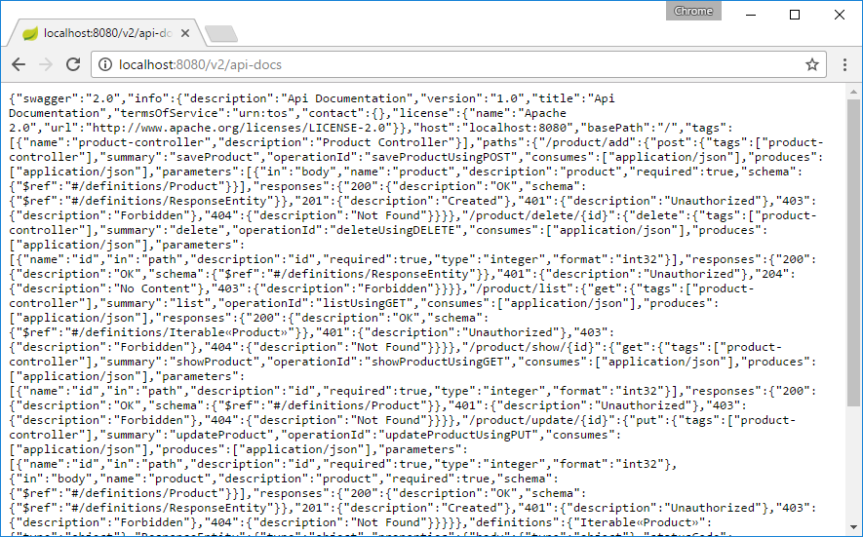
显然,Swagger 2为我们的端点生成的上述JSON转储不是我们想要的。
我们想要的是一些很好的人类可读的结构化文档,这是Swagger UI接管的地方。
在将浏览器指向http:// localhost:8080 / swagger-ui.html时,您将看到由Swagger UI呈现的生成文档,如下所示:
如你所见,Swagger 2使用了合理的默认值来生成ProductController的ProductController 。
然后,Swagger UI包装一切,为我们提供一个直观的UI。 这一切都是自动完成的。 我们没有写任何代码或其他文档来支持Swagger。
自定义Swagger
到目前为止,我们一直在看Swagger文档,因为它开箱即用 - 但Swagger 2有一些伟大的自定义选项。
让我们开始通过在SwaggerConfig类中提供有关我们的API的信息来定制Swagger。
SwaggerConfig.Java :
- package guru.springframework.config;
- import org.springframework.context.annotation.Bean;
- import org.springframework.context.annotation.Configuration;
- import springfox.documentation.builders.RequestHandlerSelectors;
- import springfox.documentation.service.ApiInfo;
- import springfox.documentation.service.Contact;
- import springfox.documentation.spi.DocumentationType;
- import springfox.documentation.spring.web.plugins.Docket;
- import springfox.documentation.swagger2.annotations.EnableSwagger2;
- import static springfox.documentation.builders.PathSelectors.regex;
- @Configuration
- @EnableSwagger2
- public class SwaggerConfig {
- @Bean
- public Docket productApi() {
- return new Docket(DocumentationType.SWAGGER_2)
- .select()
- .apis(RequestHandlerSelectors.basePackage("guru.springframework.controllers"))
- .paths(regex("/product.*"))
- .build()
- .apiInfo(metaData());
- }
- private ApiInfo metaData() {
- ApiInfo apiInfo = new ApiInfo(
- "Spring Boot REST API",
- "Spring Boot REST API for Online Store",
- "1.0",
- "Terms of service",
- new Contact("John Thompson", "https://springframework.guru/about/", "john@springfrmework.guru"),
- "Apache License Version 2.0",
- "https://www.apache.org/licenses/LICENSE-2.0");
- return apiInfo;
- }
- }
package guru.springframework.config;
import org.springframework.context.annotation.Bean;
import org.springframework.context.annotation.Configuration;
import springfox.documentation.builders.RequestHandlerSelectors;
import springfox.documentation.service.ApiInfo;
import springfox.documentation.service.Contact;
import springfox.documentation.spi.DocumentationType;
import springfox.documentation.spring.web.plugins.Docket;
import springfox.documentation.swagger2.annotations.EnableSwagger2;
import static springfox.documentation.builders.PathSelectors.regex;
@Configuration
@EnableSwagger2
public class SwaggerConfig {
@Bean
public Docket productApi() {
return new Docket(DocumentationType.SWAGGER_2)
.select()
.apis(RequestHandlerSelectors.basePackage("guru.springframework.controllers"))
.paths(regex("/product.*"))
.build()
.apiInfo(metaData());
}
private ApiInfo metaData() {
ApiInfo apiInfo = new ApiInfo(
"Spring Boot REST API",
"Spring Boot REST API for Online Store",
"1.0",
"Terms of service",
new Contact("John Thompson", "https://springframework.guru/about/", "john@springfrmework.guru"),
"Apache License Version 2.0",
"https://www.apache.org/licenses/LICENSE-2.0");
return apiInfo;
}
} 在SwaggerConfig类中,我们添加了一个metaData()方法,该方法返回和使用有关我们的API的信息ApiInfo对象。 第23行用新信息初始化Docket。
Swagger 2生成的文档现在看起来类似于:

Swagger 2 REST端点的注释
此时,如果单击产品控制器链接,Swagger UI将显示我们的操作端点的文档,如下所示:
我们可以使用ProductController类上的ProductController来描述我们的API。
- @RestController @RequestMapping("/product") @Api(value="onlinestore", description="Operations pertaining to products in Online Store") public class ProductController {
@RestController @RequestMapping("/product") @Api(value="onlinestore", description="Operations pertaining to products in Online Store") public class ProductController { Swagger UI生成的文档将反映描述,现在看起来像这样:
对于每个操作端点,我们可以使用@ApiOperation注释来描述端点及其响应类型,如下所示:
- @ApiOperation(value = "View a list of available products", response = Iterable.class)
- @RequestMapping(value = "/list", method= RequestMethod.GET,produces = "application/json")
- public Iterable list(Model model){
- Iterable productList = productService.listAllProducts();
- return productList;
- }
@ApiOperation(value = "View a list of available products", response = Iterable.class)
@RequestMapping(value = "/list", method= RequestMethod.GET,produces = "application/json")
public Iterable list(Model model){
Iterable productList = productService.listAllProducts();
return productList;
}@ApiResponse注释来记录其他响应,如下所示。
- @ApiOperation(value = "View a list of available products", response = Iterable.class)
- @ApiResponses(value = {
- @ApiResponse(code = 200, message = "Successfully retrieved list"),
- @ApiResponse(code = 401, message = "You are not authorized to view the resource"),
- @ApiResponse(code = 403, message = "Accessing the resource you were trying to reach is forbidden"),
- @ApiResponse(code = 404, message = "The resource you were trying to reach is not found")
- }
- )
- @RequestMapping(value = "/list", method= RequestMethod.GET, produces = "application/json")
- public Iterable list(Model model){
- Iterable productList = productService.listAllProducts();
- return productList;
- }
@ApiOperation(value = "View a list of available products", response = Iterable.class)
@ApiResponses(value = {
@ApiResponse(code = 200, message = "Successfully retrieved list"),
@ApiResponse(code = 401, message = "You are not authorized to view the resource"),
@ApiResponse(code = 403, message = "Accessing the resource you were trying to reach is forbidden"),
@ApiResponse(code = 404, message = "The resource you were trying to reach is not found")
}
)
@RequestMapping(value = "/list", method= RequestMethod.GET, produces = "application/json")
public Iterable list(Model model){
Iterable productList = productService.listAllProducts();
return productList;
} 花了我一些时间的一个未记录的事情与响应内容类型的价值有关。 Swagger 2生成*/* ,而我期待应用application/json响应内容类型。 只有在更新了@RequestMapping注释(产生= "application/json" 之后 , = "application/json"生成所需的值。 带注释的ProductController如下。
ProductController.java :
- package guru.springframework.controllers;
- import guru.springframework.domain.Product;
- import guru.springframework.services.ProductService;
- import io.swagger.annotations.Api;
- import io.swagger.annotations.ApiOperation;
- import io.swagger.annotations.ApiResponse;
- import io.swagger.annotations.ApiResponses;
- import org.springframework.beans.factory.annotation.Autowired;
- import org.springframework.http.HttpStatus;
- import org.springframework.http.ResponseEntity;
- import org.springframework.ui.Model;
- import org.springframework.web.bind.annotation.*;
- @RestController
- @RequestMapping("/product")
- @Api(value="onlinestore", description="Operations pertaining to products in Online Store")
- public class ProductController {
- private ProductService productService;
- @Autowired
- public void setProductService(ProductService productService) {
- this.productService = productService;
- }
- @ApiOperation(value = "View a list of available products",response = Iterable.class)
- @ApiResponses(value = {
- @ApiResponse(code = 200, message = "Successfully retrieved list"),
- @ApiResponse(code = 401, message = "You are not authorized to view the resource"),
- @ApiResponse(code = 403, message = "Accessing the resource you were trying to reach is forbidden"),
- @ApiResponse(code = 404, message = "The resource you were trying to reach is not found")
- }
- )
- @RequestMapping(value = "/list", method= RequestMethod.GET, produces = "application/json")
- public Iterable<Product> list(Model model){
- Iterable<Product> productList = productService.listAllProducts();
- return productList;
- }
- @ApiOperation(value = "Search a product with an ID",response = Product.class)
- @RequestMapping(value = "/show/{id}", method= RequestMethod.GET, produces = "application/json")
- public Product showProduct(@PathVariable Integer id, Model model){
- Product product = productService.getProductById(id);
- return product;
- }
- @ApiOperation(value = "Add a product")
- @RequestMapping(value = "/add", method = RequestMethod.POST, produces = "application/json")
- public ResponseEntity saveProduct(@RequestBody Product product){
- productService.saveProduct(product);
- return new ResponseEntity("Product saved successfully", HttpStatus.OK);
- }
- @ApiOperation(value = "Update a product")
- @RequestMapping(value = "/update/{id}", method = RequestMethod.PUT, produces = "application/json")
- public ResponseEntity updateProduct(@PathVariable Integer id, @RequestBody Product product){
- Product storedProduct = productService.getProductById(id);
- storedProduct.setDescription(product.getDescription());
- storedProduct.setImageUrl(product.getImageUrl());
- storedProduct.setPrice(product.getPrice());
- productService.saveProduct(storedProduct);
- return new ResponseEntity("Product updated successfully", HttpStatus.OK);
- }
- @ApiOperation(value = "Delete a product")
- @RequestMapping(value="/delete/{id}", method = RequestMethod.DELETE, produces = "application/json")
- public ResponseEntity delete(@PathVariable Integer id){
- productService.deleteProduct(id);
- return new ResponseEntity("Product deleted successfully", HttpStatus.OK);
- }
- }
package guru.springframework.controllers;
import guru.springframework.domain.Product;
import guru.springframework.services.ProductService;
import io.swagger.annotations.Api;
import io.swagger.annotations.ApiOperation;
import io.swagger.annotations.ApiResponse;
import io.swagger.annotations.ApiResponses;
import org.springframework.beans.factory.annotation.Autowired;
import org.springframework.http.HttpStatus;
import org.springframework.http.ResponseEntity;
import org.springframework.ui.Model;
import org.springframework.web.bind.annotation.*;
@RestController
@RequestMapping("/product")
@Api(value="onlinestore", description="Operations pertaining to products in Online Store")
public class ProductController {
private ProductService productService;
@Autowired
public void setProductService(ProductService productService) {
this.productService = productService;
}
@ApiOperation(value = "View a list of available products",response = Iterable.class)
@ApiResponses(value = {
@ApiResponse(code = 200, message = "Successfully retrieved list"),
@ApiResponse(code = 401, message = "You are not authorized to view the resource"),
@ApiResponse(code = 403, message = "Accessing the resource you were trying to reach is forbidden"),
@ApiResponse(code = 404, message = "The resource you were trying to reach is not found")
}
)
@RequestMapping(value = "/list", method= RequestMethod.GET, produces = "application/json")
public Iterable<Product> list(Model model){
Iterable<Product> productList = productService.listAllProducts();
return productList;
}
@ApiOperation(value = "Search a product with an ID",response = Product.class)
@RequestMapping(value = "/show/{id}", method= RequestMethod.GET, produces = "application/json")
public Product showProduct(@PathVariable Integer id, Model model){
Product product = productService.getProductById(id);
return product;
}
@ApiOperation(value = "Add a product")
@RequestMapping(value = "/add", method = RequestMethod.POST, produces = "application/json")
public ResponseEntity saveProduct(@RequestBody Product product){
productService.saveProduct(product);
return new ResponseEntity("Product saved successfully", HttpStatus.OK);
}
@ApiOperation(value = "Update a product")
@RequestMapping(value = "/update/{id}", method = RequestMethod.PUT, produces = "application/json")
public ResponseEntity updateProduct(@PathVariable Integer id, @RequestBody Product product){
Product storedProduct = productService.getProductById(id);
storedProduct.setDescription(product.getDescription());
storedProduct.setImageUrl(product.getImageUrl());
storedProduct.setPrice(product.getPrice());
productService.saveProduct(storedProduct);
return new ResponseEntity("Product updated successfully", HttpStatus.OK);
}
@ApiOperation(value = "Delete a product")
@RequestMapping(value="/delete/{id}", method = RequestMethod.DELETE, produces = "application/json")
public ResponseEntity delete(@PathVariable Integer id){
productService.deleteProduct(id);
return new ResponseEntity("Product deleted successfully", HttpStatus.OK);
}
}
当前文档缺少一件事:产品JPA实体的文档。 我们将为我们的模型生成文档。
Swagger 2注释模型
您可以使用@ApiModelProperty注释来描述Product模型的属性。 使用@ApiModelProperty ,您还可以根据需要记录属性。
我们的产品类的代码是这样的。
Product.java :
- package guru.springframework.domain;
- import io.swagger.annotations.ApiModelProperty;
- import javax.persistence.*;
- import java.math.BigDecimal;
- @Entity
- public class Product {
- @Id
- @GeneratedValue(strategy = GenerationType.AUTO)
- @ApiModelProperty(notes = "The database generated product ID")
- private Integer id;
- @Version
- @ApiModelProperty(notes = "The auto-generated version of the product")
- private Integer version;
- @ApiModelProperty(notes = "The application-specific product ID")
- private String productId;
- @ApiModelProperty(notes = "The product description")
- private String description;
- @ApiModelProperty(notes = "The image URL of the product")
- private String imageUrl;
- @ApiModelProperty(notes = "The price of the product", required = true)
- private BigDecimal price;
- public String getDescription() {
- return description;
- }
- public void setDescription(String description) {
- this.description = description;
- }
- public Integer getVersion() {
- return version;
- }
- public void setVersion(Integer version) {
- this.version = version;
- }
- public Integer getId() {
- return id;
- }
- public void setId(Integer id) {
- this.id = id;
- }
- public String getProductId() {
- return productId;
- }
- public void setProductId(String productId) {
- this.productId = productId;
- }
- public String getImageUrl() {
- return imageUrl;
- }
- public void setImageUrl(String imageUrl) {
- this.imageUrl = imageUrl;
- }
- public BigDecimal getPrice() {
- return price;
- }
- public void setPrice(BigDecimal price) {
- this.price = price;
- }
- }
package guru.springframework.domain;
import io.swagger.annotations.ApiModelProperty;
import javax.persistence.*;
import java.math.BigDecimal;
@Entity
public class Product {
@Id
@GeneratedValue(strategy = GenerationType.AUTO)
@ApiModelProperty(notes = "The database generated product ID")
private Integer id;
@Version
@ApiModelProperty(notes = "The auto-generated version of the product")
private Integer version;
@ApiModelProperty(notes = "The application-specific product ID")
private String productId;
@ApiModelProperty(notes = "The product description")
private String description;
@ApiModelProperty(notes = "The image URL of the product")
private String imageUrl;
@ApiModelProperty(notes = "The price of the product", required = true)
private BigDecimal price;
public String getDescription() {
return description;
}
public void setDescription(String description) {
this.description = description;
}
public Integer getVersion() {
return version;
}
public void setVersion(Integer version) {
this.version = version;
}
public Integer getId() {
return id;
}
public void setId(Integer id) {
this.id = id;
}
public String getProductId() {
return productId;
}
public void setProductId(String productId) {
this.productId = productId;
}
public String getImageUrl() {
return imageUrl;
}
public void setImageUrl(String imageUrl) {
this.imageUrl = imageUrl;
}
public BigDecimal getPrice() {
return price;
}
public void setPrice(BigDecimal price) {
this.price = price;
}
}
总结
除了使用Swagger Core和Swagger UI的REST API文档和演示外,Swagger 2还有许多其他用途,超出了本文的范围。 我最喜欢的一个是Swagger Editor,一个工具来设计新的API或编辑现有的API。 编辑器可视化呈现您的Swagger定义,并提供实时错误反馈。 另一个是Swagger Codegen ,一个代码生成框架,用于构建来自Swagger定义的客户端SDK,服务器和文档。
Swagger 2还支持通过JSON和YAML文件定义Swagger。 如果你想通过在JSON和YAML文件中外部化它们来避免代码库中特定于实现的代码,那么你应该尝试一些东西 - 这将在以后的文章中介绍。








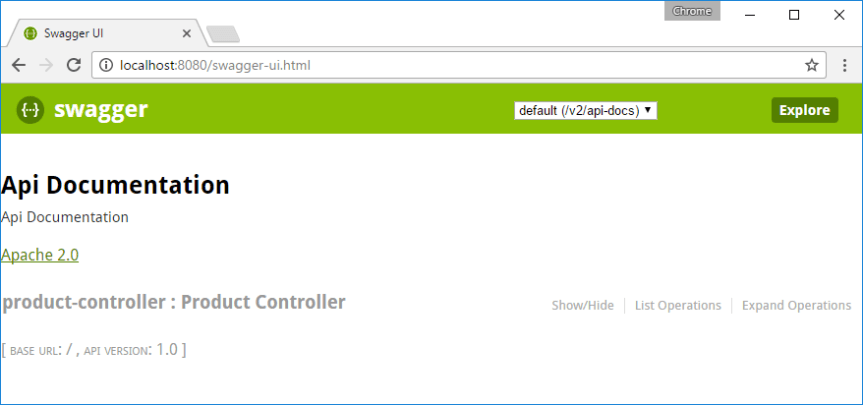

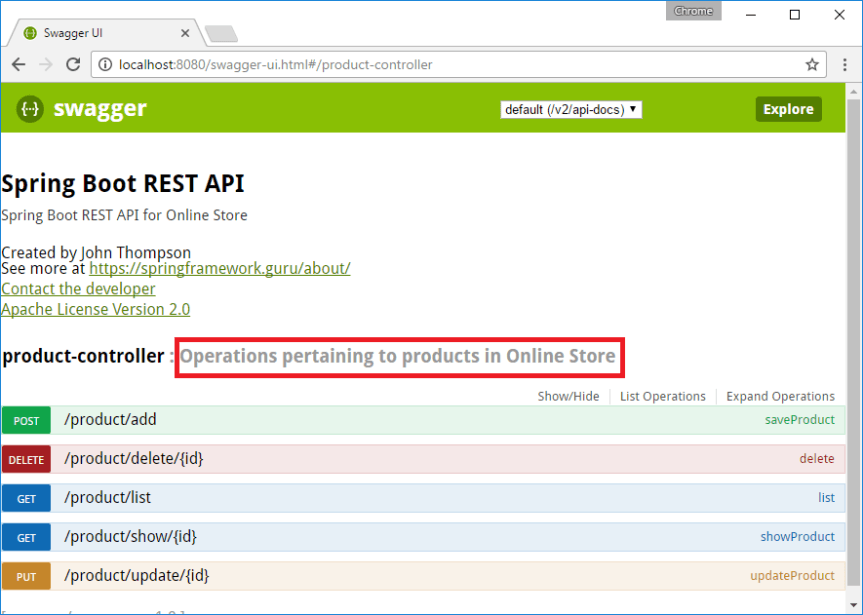
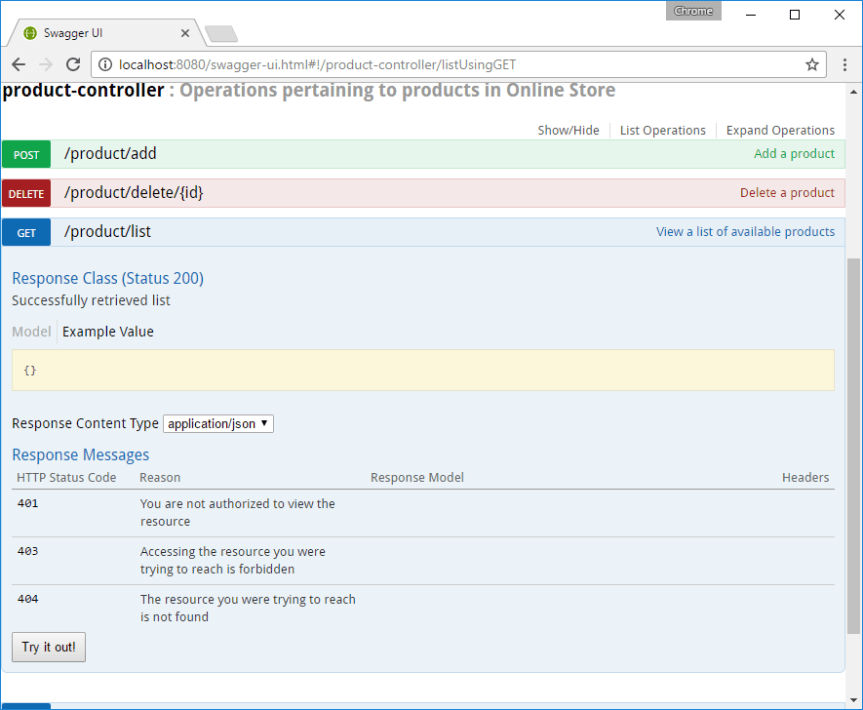
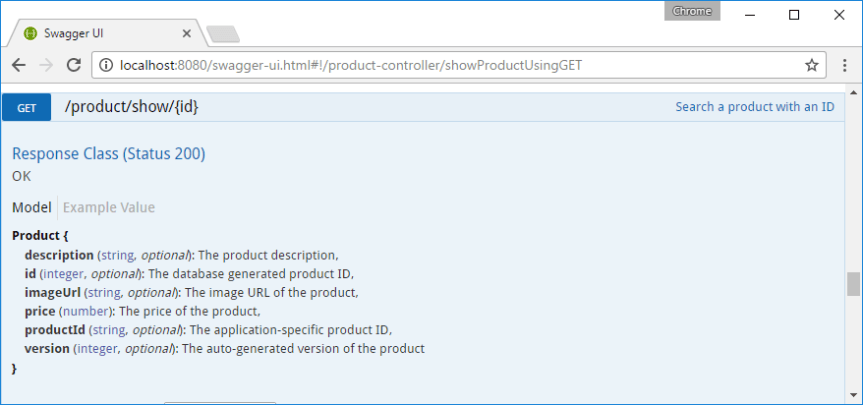














 877
877

 被折叠的 条评论
为什么被折叠?
被折叠的 条评论
为什么被折叠?








